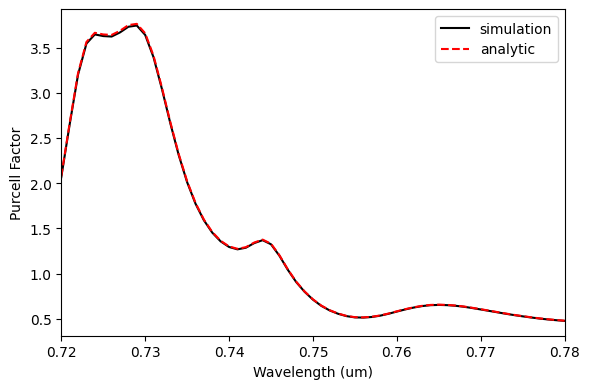Particle swarm optimization of a bullseye cavity for quantum emitter light extraction#
Note: the cost of running the entire notebook is higher than 1 FlexCredit.
A bullseye cavity is characterized by concentric rings of alternating dielectrics, resembling a bullseye target. It has been successfully employed to enhance the collection efficiency and decay rate of various quantum emitters, including quantum dots, defect centers in diamond, and 2D materials.
In this notebook, we show how to set up a bullseye cavity simulation using Tidy3D and use Particle Swarm Optimization (PSO) to enhance the coupling efficiency from quantum emitters into the fundamental mode of an optical fiber. We will use the free available python library `PySwarms <https://pyswarms.readthedocs.io/en/latest/index.html>`__ for running PSO. For details about PSO you can see the notebook Particle swarm optimization of a polarization beam
splitter. In addition, we show how to calculate the cavity Purcell factor, which is another important figure-of-merit within the context of cavity electrodynamics.
Let’s start by importing the python libraries used throughout this notebook.
[1]:
# Standard python imports.
import numpy as np
import matplotlib.pylab as plt
from pyswarms.single.global_best import GlobalBestPSO
# Import regular tidy3d.
import tidy3d as td
import tidy3d.web as web
from tidy3d.plugins.mode import ModeSolver
from tidy3d.plugins.mode.web import run as run_mode_solver
Cavity Geometry and Simulation Parameters#
The cavity structure is inspired by Hekmati, R., Hadden, J.P., Mathew, A. et al. Bullseye dielectric cavities for photon collection from a surface-mounted quantum-light-emitter. Sci Rep 13, 5316 (2023) DOI: 10.1038/s41598-023-32359-0, where the authors presented a \(TiO_{2}\) over \(SiO_{2}\) bullseye cavity. In that work, the cavity was designed to enhance the emission from point sources, such as \(WSe_{2}\) flakes, single dye
molecules, and nano-diamonds, positioned just above the center of the structure. It was optimized using an iterative approach to enhance the power coupling into the numerical aperture (NA) of free-space optics and a low NA fiber.
Differently from that work, here we will set up the optimization to enhance the modal coupling efficiency of the generated photons into the collection fiber. When building an optimization scheme for practical applications, more advanced optimization strategies can be implemented to include other quantities of interest—for instance, the Purcell factor, which is important within the context of devices such as single-photon sources. The following figure shows the main cavity geometric parameters.

[2]:
# Initial parameters of the Bullseye cavity.
t_tio2 = 0.200 # TiO2 thin film thickness (um).
t_sio2 = 0.435 # SiO2 thin film thickness (um).
r_cav = 0.835 # Radius of the internal cavity (um).
p_bragg = 0.420 # Period of the Bragg reflector (um).
w_bragg = 0.155 # Gap width (etched region) of the Bragg reflector (um).
n_bragg = 8 # Number of Bragg periods.
n_tio2 = 2.50 # TiO2 refractive index (0.75 um).
n_sio2 = 1.45 # SiO2 refractive index (0.75 um).
# Collection fiber parameters (630HP).
r_core = 1.75 # Fiber core radius.
n_core = 1.46 # Core refractive index.
n_clad = 1.45 # Cladding refractive index.
d_cf = 2.0 # Distance between the cavity and the fiber.
# PSO optimization parameters.
iterations = 15 # Number of iterations.
n_particle = 5 # Number of particles in optimization.
# Simulation wavelength.
wl = 0.75 # Central simulation wavelength (um).
bw = 0.06 # Simulation bandwidth (um).
n_wl = 61 # Number of wavelength points within the bandwidth.
From the parameters defined before, a lot of variables are computed and used to set up the optimization.
[3]:
# Wavelengths and frequencies.
wl_max = wl + bw / 2
wl_min = wl - bw / 2
wl_range = np.linspace(wl_min, wl_max, n_wl)
freq = td.C_0 / wl
freqs = td.C_0 / wl_range
freqw = 0.5 * (freqs[0] - freqs[-1])
run_time = 5e-12 # Simulation run time.
# Material definition.
mat_tio2 = td.Medium(permittivity=n_tio2 ** 2) # TiO2 medium.
mat_sio2 = td.Medium(permittivity=n_sio2 ** 2) # SiO2 medium.
mat_etch = td.Medium(permittivity=1) # Etch medium.
mat_core = td.Medium(permittivity=n_core ** 2) # Fiber core medium.
mat_clad = td.Medium(permittivity=n_clad ** 2) # Fiber cladding medium.
# Computational domain size.
pml_spacing = 0.6 * wl
eff_inf = 10
Bullseye Cavity Set Up#
We start with the definition of a function to build the bullseye cavity simulation. The PSO algorithm passes 6 parameters to this function, which in turn returns a simulation object. The quantum emitter is modeled as a y-oriented PointDipole placed at the top of the cavity surface. A ModeMonitor calculates the power coupled into the fiber fundamental mode, and a FluxMonitor gets the total dipole power. We are using a PECBoundary condition in the -z direction as a metallic
reflector at the bottom of the \(SiO_{2}\) layer.
[4]:
def get_simulation(
r=r_cav, # Cavity radius.
p=p_bragg, # Cavity period.
w=w_bragg, # Etched width.
h=0.0, # Non-etched thickness with respect to TiO2 thickness.
tsio2=t_sio2, # SiO2 layer thickness.
dcf=d_cf, # Cavity to fiber distance.
):
# Computational domain size.
size_x = 2 * pml_spacing + max(2 * (r + n_bragg * p), 2 * r_core)
size_y = size_x
size_z = pml_spacing + tsio2 + t_tio2 + dcf
center_z = -size_z / 2
qd_pos_z = tsio2 + t_tio2
mon_pos_z = size_z - pml_spacing / 2
# Point dipole source located at the center of TiO2 thin film.
dp_source = td.PointDipole(
center=(0, 0, qd_pos_z),
source_time=td.GaussianPulse(freq0=freq, fwidth=freqw),
polarization="Ey",
)
# Field monitor to visualize the fields in xy plane.
field_monitor_xy = td.FieldMonitor(
center=(0, 0, qd_pos_z - t_tio2 / 2),
size=(size_x, size_y, 0),
freqs=[freq],
name="field_xy",
)
# Field monitor to visualize the fields in xz plane.
field_monitor_xz = td.FieldMonitor(
center=(0, 0.05, size_z / 2),
size=(size_x, 0, size_z),
freqs=[freq],
name="field_xz",
)
# Mode monitor to get the power coupled into the fiber modes.
mode_spec = td.ModeSpec(num_modes=1, target_neff=n_core)
mode_monitor = td.ModeMonitor(
center=(0, 0, mon_pos_z),
size=(size_x, size_y, 0),
freqs=freqs,
mode_spec=mode_spec,
name="mode_fiber",
)
# Flux monitor to get the total dipole power.
flux_dip = td.FluxMonitor(
center=(0, 0, size_z / 2),
size=(0.8*size_x, 0.8*size_y, size_z),
freqs=freqs,
exclude_surfaces=("z-",),
name="flux_dip",
)
# Silicon dioxide layer
sio2_layer = td.Structure(
geometry=td.Box.from_bounds(
rmin=(-size_x / 2 - eff_inf, -size_y / 2 - eff_inf, -eff_inf),
rmax=(size_x / 2 + eff_inf, size_y / 2 + eff_inf, tsio2),
),
medium=mat_sio2,
)
# Fiber cladding
fiber_clad = td.Structure(
geometry=td.Box.from_bounds(
rmin=(-size_x / 2 - eff_inf, -size_y / 2 - eff_inf, size_z - pml_spacing),
rmax=(size_x / 2 + eff_inf, size_y / 2 + eff_inf, size_z + eff_inf),
),
medium=mat_clad,
)
# Fiber core
fiber_core = td.Structure(
geometry=td.Cylinder(
radius=r_core,
center=(0, 0, size_z + (((pml_spacing + eff_inf) / 2) - pml_spacing)),
axis=2,
length=pml_spacing + eff_inf,
),
medium=mat_core,
)
# Bullseye cavity
bullseye = []
cyl_rad = n_bragg * p + r
for _ in range(0, n_bragg):
bullseye.append(
td.Structure(
geometry=td.Cylinder(
radius=cyl_rad,
center=(0, 0, qd_pos_z - t_tio2 / 2),
axis=2,
length=t_tio2,
),
medium=mat_tio2,
)
)
bullseye.append(
td.Structure(
geometry=td.Cylinder(
radius=cyl_rad - p + w,
center=(0, 0, qd_pos_z - t_tio2 / 2),
axis=2,
length=t_tio2,
),
medium=mat_etch,
)
)
cyl_rad -= p
bullseye.append(
td.Structure(
geometry=td.Cylinder(
radius=r, center=(0, 0, qd_pos_z - t_tio2 / 2), axis=2, length=t_tio2
),
medium=mat_tio2,
)
)
# Non-etched TiO2 region.
if h > 0:
bullseye.append(
td.Structure(
geometry=td.Box.from_bounds(
rmin=(-size_x / 2 - eff_inf, -size_y / 2 - eff_inf, tsio2),
rmax=(
size_x / 2 + eff_inf,
size_y / 2 + eff_inf,
tsio2 + h * t_tio2,
),
),
medium=mat_tio2,
)
)
# Simulation definition
sim = td.Simulation(
center=(0, 0, -center_z),
size=(size_x, size_y, size_z),
medium=mat_etch,
grid_spec=td.GridSpec.auto(min_steps_per_wvl=15, wavelength=wl),
structures=[sio2_layer, fiber_clad, fiber_core] + bullseye,
sources=[dp_source],
normalize_index=0,
monitors=[field_monitor_xy, field_monitor_xz, mode_monitor, flux_dip],
boundary_spec=td.BoundarySpec(
x=td.Boundary.pml(),
y=td.Boundary.pml(),
z=td.Boundary(minus=td.PECBoundary(), plus=td.PML()),
),
symmetry=(1, -1, 0),
run_time=run_time,
)
return sim
Let’s visualize the simulation set up and verify if all the elements are in their correct places.
[5]:
init_design = get_simulation()
fig = plt.figure(tight_layout=True, figsize=(10, 5))
gs = fig.add_gridspec(2, 2)
ax1 = fig.add_subplot(gs[:, 0])
ax2 = fig.add_subplot(gs[0, 1])
ax3 = fig.add_subplot(gs[1, 1])
init_design.plot_eps(z=t_sio2 + t_tio2, ax=ax1, monitor_alpha=0)
init_design.plot(y=0, ax=ax2, monitor_alpha=0)
init_design.plot_eps(y=0, ax=ax3)
plt.show()
[18:18:14] WARNING: Default value for the field monitor monitor.py:261 'colocate' setting has changed to 'True' in Tidy3D 2.4.0. All field components will be colocated to the grid boundaries. Set to 'False' to get the raw fields on the Yee grid instead.
WARNING: Default value for the field monitor monitor.py:261 'colocate' setting has changed to 'True' in Tidy3D 2.4.0. All field components will be colocated to the grid boundaries. Set to 'False' to get the raw fields on the Yee grid instead.
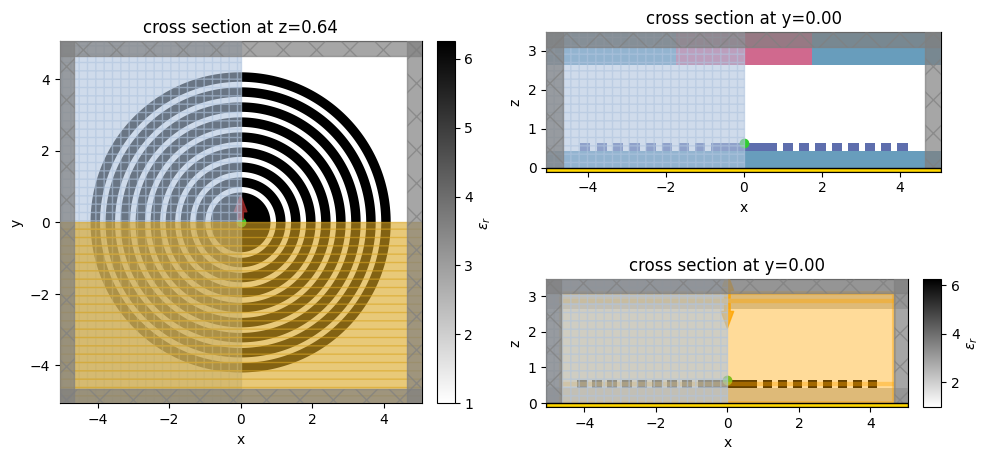
Output Fiber Mode#
Before running the optimization, we will make sure the correct optical fiber mode has been considered.
[6]:
mode_spec = td.ModeSpec(num_modes=1, target_neff=n_core)
mode_solver = ModeSolver(
simulation=init_design,
plane=td.Box(
center=(0, 0, 0.5 * pml_spacing + t_sio2 + t_tio2 + d_cf),
size=(td.inf, td.inf, 0),
),
mode_spec=mode_spec,
freqs=[freq],
)
mode_fiber = run_mode_solver(mode_solver)
We can see the y-oriented fundamental optical fiber mode, as desired.
[7]:
fig, ax = plt.subplots(1, 1, figsize=(5, 4), tight_layout=True)
mode_fiber.Ey.real.sel(mode_index=0, f=freq).plot(x="x", y="y", cmap="bwr", ax=ax)
plt.show()
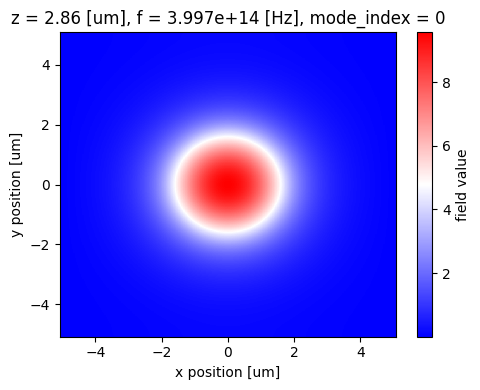
Particle Swarm Optimization#
The figure-of-merit used in the optimization is the coupling efficiency of generated photons into the fundamental optical mode of the collection fiber. We need to normalize the modal power by the dipole power to obtain the correct value, as below.
[8]:
# Figure of Merit (FOM) calculation.
def get_coupling_eff(sim_data: td.SimulationData) -> float:
"""Return the power at the mode index of interest."""
mode_amps = sim_data["mode_fiber"].amps.sel(direction="+", mode_index=0)
mode_power = np.squeeze(np.abs(mode_amps) ** 2)
dip_power = sim_data["flux_dip"].flux
return mode_power / dip_power
Now, we can define the objective function passed to the PSO algorithm. This function receives a (n_particles, dimensions) array, where n_particles is the number of particles the optimization algorithm will move throughout the parameter space, and dimensions are the degrees of freedom (6). The n_particles simulations are submitted at once to the Tidy3D cloud, thus reducing the total optimization considerably.
[9]:
def obj(x, verbose: bool = False) -> float:
# Objective values for each particle.
obj_val = []
# Create a simulation batch to run all the particles at once.
sim_batch = {
f"sim_r:{r}_p:{p}_w:{w}_h:{h}_t:{t}_d:{d}": get_simulation(
r=r, p=p, w=w, h=h, tsio2=t, dcf=d
)
for r, p, w, h, t, d in zip(
x[:, 0], x[:, 1], x[:, 2], x[:, 3], x[:, 4], x[:, 5]
)
}
# Run the simulation batch.
batch_data = web.run_async(simulations=sim_batch, path_dir="data", verbose=verbose)
# Get the results.
for _, sim_data in batch_data.items():
ce = get_coupling_eff(sim_data)
ce = np.amax(ce)
obj_val.append(-ce)
return np.asarray(obj_val)
Before starting the optimization, we need to define the bounds for the optimization parameters. Initial conditions are optional but necessary if results reproducibility is a concern.
[10]:
x_max = np.asarray(
[1.5 * r_cav, 1.5 * p_bragg, 1.5 * w_bragg, 1.0, 1.5 * t_sio2, 1.5 * d_cf]
)
x_min = np.asarray(
[0.5 * r_cav, 0.5 * p_bragg, 0.5 * w_bragg, 0.0, 0.5 * t_sio2, 0.5 * d_cf]
)
bounds = (x_min, x_max)
# Initial parameters
np.random.seed(123)
init_par = np.random.uniform(0.5, 1.0, (n_particle, x_max.shape[0]))
init_par[:, 0] = init_par[:, 0] * r_cav
init_par[:, 1] = init_par[:, 1] * p_bragg
init_par[:, 2] = init_par[:, 2] * w_bragg
init_par[:, 3] = init_par[:, 3] - 0.5
init_par[:, 4] = init_par[:, 4] * t_sio2
init_par[:, 5] = init_par[:, 5] * d_cf
# Initialization of PSO global optimizer.
options = {"c1": 0.5, "c2": 0.3, "w": 0.9}
optimizer = GlobalBestPSO(
n_particles=n_particle,
dimensions=x_max.shape[0],
options=options,
bounds=bounds,
init_pos=init_par,
)
Now, we are ready to run the optimization!
[11]:
td.config.logging_level = "ERROR"
# Run the optimization.
best_ce, best_par = optimizer.optimize(obj, iterations)
best_ce = np.abs(best_ce)
2023-09-21 18:19:02,308 - pyswarms.single.global_best - INFO - Optimize for 15 iters with {'c1': 0.5, 'c2': 0.3, 'w': 0.9}
pyswarms.single.global_best: 100%|██████████|15/15, best_cost=-.397
2023-09-21 19:21:50,928 - pyswarms.single.global_best - INFO - Optimization finished | best cost: -0.3974066414798787, best pos: [0.51796414 0.40680774 0.12680785 0.23418567 0.28031486 1.58226138]
Ultimately, we can obtain the optimized cavity parameters and see how the optimization has evolved into the final value. We have obtained a 4-fold improvement in coupling efficiency along the optimization. When optimizing a device for practical applications, one can consider adding more particles, increasing the number of iterations, or trying different metaparameters to improve results.
[12]:
print(f"Best parameters:")
print(f"r_cav = {best_par[0]:.3f} um")
print(f"p_bragg = {best_par[1]:.3f} um")
print(f"w_bragg = {best_par[2]:.3f} um")
print(f"h = {best_par[3]:.3f}")
print(f"t_sio2 = {best_par[4]:.3f} um")
print(f"d_cf = {best_par[5]:.3f} um")
fig, ax = plt.subplots(1, 1, figsize=(6, 4))
ax.plot(optimizer.cost_history, "ro")
ax.set_xlabel("iterations")
ax.set_ylabel("objective function")
ax.set_title(f"Final coupling efficiency = {best_ce:.3f}")
plt.show()
Best parameters:
r_cav = 0.518 um
p_bragg = 0.407 um
w_bragg = 0.127 um
h = 0.234
t_sio2 = 0.280 um
d_cf = 1.582 um
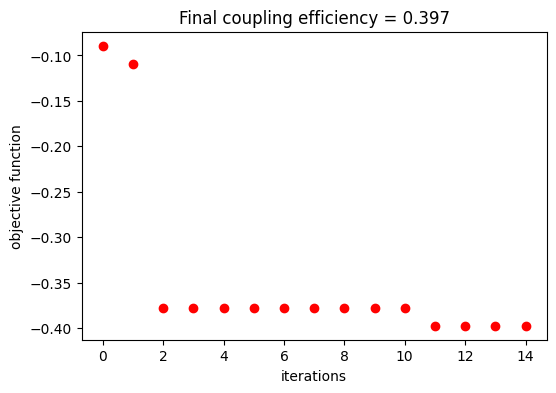
Final Bullseye Cavity#
Now, we can simulate the optimized bullseye cavity and take a look at the coupling efficiency along the whole bandwidth.
[13]:
final_design = get_simulation(
r=best_par[0],
p=best_par[1],
w=best_par[2],
h=best_par[3],
tsio2=best_par[4],
dcf=best_par[5],
)
# Field monitor to visualize the fields at the peak coupling efficiency.
wl_mon = 0.725 # Wavelength for field monitor.
field_monitor_xz_f = td.FieldMonitor(
center=(0, 0.05, final_design.center[2]/2),
size=(final_design.size[0], 0, final_design.size[2]),
freqs=[td.C_0/wl_mon],
name="field_xz_f",
)
mon_f = final_design.monitors + (field_monitor_xz_f,)
final_design = final_design.copy(update=dict(monitors=mon_f))
fig, (ax1, ax2) = plt.subplots(1, 2, tight_layout=True, figsize=(10, 5))
final_design.plot_eps(z=best_par[4] + t_tio2 / 1.5, ax=ax1)
final_design.plot_eps(y=0, ax=ax2)
plt.show()

[14]:
sim_data_final = web.run(final_design, task_name="final bullseye")
View task using web UI at webapi.py:190 'https://tidy3d.simulation.cloud/workbench?taskId=fdve- 0db9ed7e-dcdc-4dba-9b9e-38b253f1e05bv1'.
The peak coupling efficiency is about 40% at 0.725 \(\mu m\).
[15]:
coup_eff = get_coupling_eff(sim_data_final)
f, (ax1, ax2) = plt.subplots(1, 2, figsize=(10, 4), tight_layout=True)
ax1.plot(wl_range, coup_eff, "-k")
ax1.set_xlabel("Wavelength (um)")
ax1.set_ylabel("Coupling Efficiency")
ax1.set_xlim(wl - bw / 2, wl + bw / 2)
sim_data_final.plot_field("field_xz_f", "E", "abs^2", ax=ax2)
ax2.set_aspect("auto")
plt.show()

Purcell Factor Calculation#
Purcell factor enhancement is usually desired when designing a quantum emitter light extractor device, as it can lead to higher photon generation rates, \(\beta\)-factors, and photon indistinguishability. Next, we calculate the bullseye nanocavity Purcell factor (\(F_{p} = P_{cav}/P_{bulk}\)) defined as the ratio between the dipole power emitted in final device and in the bulk semiconductor.
We can calculate \(P_{bulk}\) analytically as
\(P_{bulk_a} = \frac{\omega^{2}}{12\pi}\frac{\mu_{0}n}{c}\)
where \(n\) is the refractive index of the quantum emitter host material.
[16]:
p_bulk_a = ((2 * np.pi * freqs) ** 2 / (12 * np.pi)) * (td.MU_0 * n_tio2 / td.C_0)
When symmetries are present in the simulation, dipole image charges are included for each symmetry plane due to field continuity reasons. In this case, we need to adjust \(P_{bulk_a}\) as below:
[17]:
p_bulk_a = p_bulk_a * 2 ** (2 * np.sum(np.abs(final_design.symmetry)))
Another way of obtaining \(P_{bulk}\) is through a normalization run considering the quantum emitter embedded in a homogeneous medium, as follows. Note that the same symmetry condition of the cavity simulation should be used.
[18]:
# Point dipole source located at the center of TiO2 thin film.
dp_source_bulk = td.PointDipole(
center=(0, 0, final_design.size[2] / 2),
source_time=td.GaussianPulse(freq0=freq, fwidth=freqw),
polarization="Ey",
)
# Flux monitor to get the total dipole power.
flux_dip_bulk = td.FluxMonitor(
center=(0, 0, final_design.size[2] / 2),
size=final_design.size,
freqs=freqs,
name="flux_dip_bulk",
)
bulk_device = final_design.copy(
update={
"structures": [],
"sources": [dp_source_bulk],
"monitors": [flux_dip_bulk],
"medium": mat_tio2,
"symmetry": final_design.symmetry,
"boundary_spec": td.BoundarySpec.all_sides(boundary=td.PML()),
}
)
fig, (ax1, ax2) = plt.subplots(1, 2, tight_layout=True, figsize=(10, 5))
bulk_device.plot_eps(z=(final_design.size[2]) / 2, ax=ax1)
bulk_device.plot_eps(y=0, ax=ax2)
plt.show()
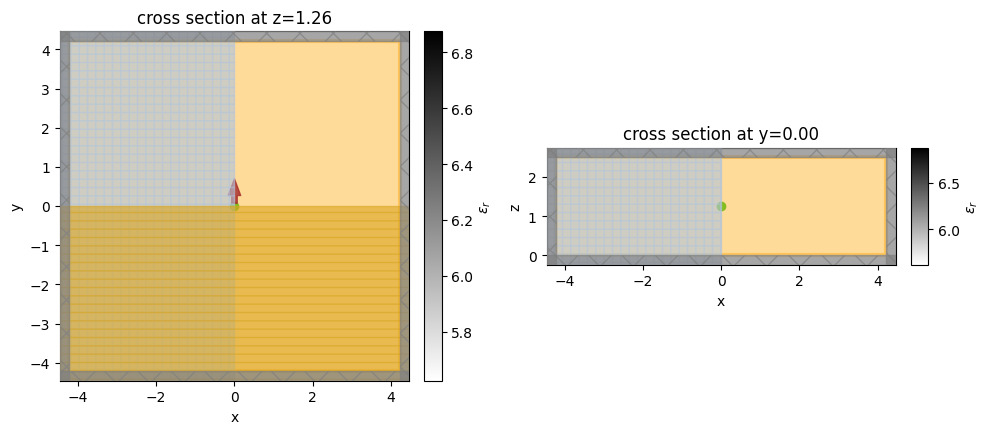
[19]:
sim_data_bulk = web.run(bulk_device, task_name="bulk sim")
View task using web UI at webapi.py:190 'https://tidy3d.simulation.cloud/workbench?taskId=fdve- 90331180-da76-4e97-86b5-9db3c00bb9bdv1'.
A maximum Purcell value of about 3.7 is achieved at 0.73 \(\mu m\), even though this figure-of-merit was not pursued along the optimization. Higher Purcell values can be obtained in cases where the quantum emitter can be embedded within the cavity material.
[20]:
p_cav = sim_data_final["flux_dip"].flux
p_bulk_s = sim_data_bulk["flux_dip_bulk"].flux
purcell_s = p_cav / p_bulk_s
purcell_a = p_cav / p_bulk_a
f, ax1 = plt.subplots(1, 1, figsize=(6, 4), tight_layout=True)
ax1.plot(wl_range, purcell_s, "-k", label="simulation")
ax1.plot(wl_range, purcell_a, "--r", label="analytic")
ax1.set_xlabel("Wavelength (um)")
ax1.set_ylabel("Purcell Factor")
ax1.set_xlim(wl - bw / 2, wl + bw / 2)
plt.legend()
plt.show()
